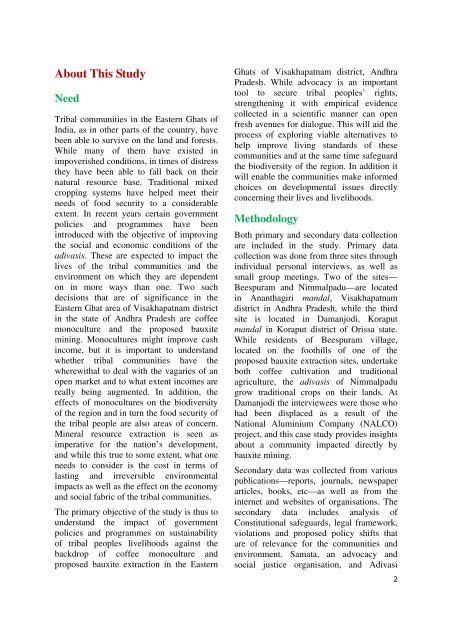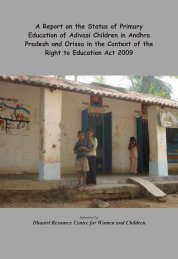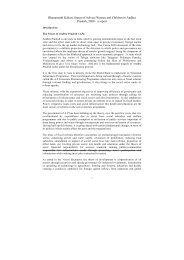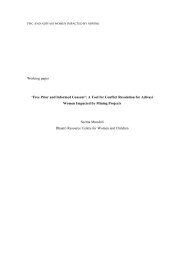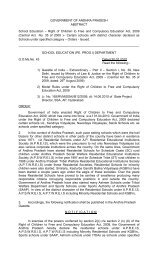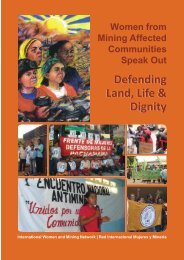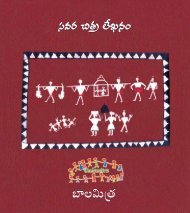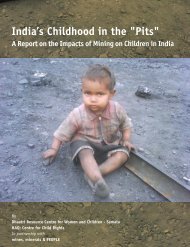Impacts of Government Policies on Sustenance of Tribal ... - Samata
Impacts of Government Policies on Sustenance of Tribal ... - Samata
Impacts of Government Policies on Sustenance of Tribal ... - Samata
You also want an ePaper? Increase the reach of your titles
YUMPU automatically turns print PDFs into web optimized ePapers that Google loves.
About This StudyNeed<strong>Tribal</strong> communities in the Eastern Ghats <str<strong>on</strong>g>of</str<strong>on</strong>g>India, as in other parts <str<strong>on</strong>g>of</str<strong>on</strong>g> the country, havebeen able to survive <strong>on</strong> the land and forests.While many <str<strong>on</strong>g>of</str<strong>on</strong>g> them have existed inimpoverished c<strong>on</strong>diti<strong>on</strong>s, in times <str<strong>on</strong>g>of</str<strong>on</strong>g> distressthey have been able to fall back <strong>on</strong> theirnatural resource base. Traditi<strong>on</strong>al mixedcropping systems have helped meet theirneeds <str<strong>on</strong>g>of</str<strong>on</strong>g> food security to a c<strong>on</strong>siderableextent. In recent years certain governmentpolicies and programmes have beenintroduced with the objective <str<strong>on</strong>g>of</str<strong>on</strong>g> improvingthe social and ec<strong>on</strong>omic c<strong>on</strong>diti<strong>on</strong>s <str<strong>on</strong>g>of</str<strong>on</strong>g> theadivasis. These are expected to impact thelives <str<strong>on</strong>g>of</str<strong>on</strong>g> the tribal communities and theenvir<strong>on</strong>ment <strong>on</strong> which they are dependent<strong>on</strong> in more ways than <strong>on</strong>e. Two suchdecisi<strong>on</strong>s that are <str<strong>on</strong>g>of</str<strong>on</strong>g> significance in theEastern Ghat area <str<strong>on</strong>g>of</str<strong>on</strong>g> Visakhapatnam districtin the state <str<strong>on</strong>g>of</str<strong>on</strong>g> Andhra Pradesh are c<str<strong>on</strong>g>of</str<strong>on</strong>g>feem<strong>on</strong>oculture and the proposed bauxitemining. M<strong>on</strong>ocultures might improve cashincome, but it is important to understandwhether tribal communities have thewherewithal to deal with the vagaries <str<strong>on</strong>g>of</str<strong>on</strong>g> anopen market and to what extent incomes arereally being augmented. In additi<strong>on</strong>, theeffects <str<strong>on</strong>g>of</str<strong>on</strong>g> m<strong>on</strong>ocultures <strong>on</strong> the biodiversity<str<strong>on</strong>g>of</str<strong>on</strong>g> the regi<strong>on</strong> and in turn the food security <str<strong>on</strong>g>of</str<strong>on</strong>g>the tribal people are also areas <str<strong>on</strong>g>of</str<strong>on</strong>g> c<strong>on</strong>cern.Mineral resource extracti<strong>on</strong> is seen asimperative for the nati<strong>on</strong>’s development,and while this true to some extent, what <strong>on</strong>eneeds to c<strong>on</strong>sider is the cost in terms <str<strong>on</strong>g>of</str<strong>on</strong>g>lasting and irreversible envir<strong>on</strong>mentalimpacts as well as the effect <strong>on</strong> the ec<strong>on</strong>omyand social fabric <str<strong>on</strong>g>of</str<strong>on</strong>g> the tribal communities.The primary objective <str<strong>on</strong>g>of</str<strong>on</strong>g> the study is thus tounderstand the impact <str<strong>on</strong>g>of</str<strong>on</strong>g> governmentpolicies and programmes <strong>on</strong> sustainability<str<strong>on</strong>g>of</str<strong>on</strong>g> tribal peoples livelihoods against thebackdrop <str<strong>on</strong>g>of</str<strong>on</strong>g> c<str<strong>on</strong>g>of</str<strong>on</strong>g>fee m<strong>on</strong>oculture andproposed bauxite extracti<strong>on</strong> in the EasternGhats <str<strong>on</strong>g>of</str<strong>on</strong>g> Visakhapatnam district, AndhraPradesh. While advocacy is an importanttool to secure tribal peoples’ rights,strengthening it with empirical evidencecollected in a scientific manner can openfresh avenues for dialogue. This will aid theprocess <str<strong>on</strong>g>of</str<strong>on</strong>g> exploring viable alternatives tohelp improve living standards <str<strong>on</strong>g>of</str<strong>on</strong>g> thesecommunities and at the same time safeguardthe biodiversity <str<strong>on</strong>g>of</str<strong>on</strong>g> the regi<strong>on</strong>. In additi<strong>on</strong> itwill enable the communities make informedchoices <strong>on</strong> developmental issues directlyc<strong>on</strong>cerning their lives and livelihoods.MethodologyBoth primary and sec<strong>on</strong>dary data collecti<strong>on</strong>are included in the study. Primary datacollecti<strong>on</strong> was d<strong>on</strong>e from three sites throughindividual pers<strong>on</strong>al interviews, as well assmall group meetings. Two <str<strong>on</strong>g>of</str<strong>on</strong>g> the sites—Beespuram and Nimmalpadu—are locatedin Ananthagiri mandal, Visakhapatnamdistrict in Andhra Pradesh, while the thirdsite is located in Damanjodi, Koraputmandal in Koraput district <str<strong>on</strong>g>of</str<strong>on</strong>g> Orissa state.While residents <str<strong>on</strong>g>of</str<strong>on</strong>g> Beespuram village,located <strong>on</strong> the foothills <str<strong>on</strong>g>of</str<strong>on</strong>g> <strong>on</strong>e <str<strong>on</strong>g>of</str<strong>on</strong>g> theproposed bauxite extracti<strong>on</strong> sites, undertakeboth c<str<strong>on</strong>g>of</str<strong>on</strong>g>fee cultivati<strong>on</strong> and traditi<strong>on</strong>alagriculture, the adivasis <str<strong>on</strong>g>of</str<strong>on</strong>g> Nimmalpadugrow traditi<strong>on</strong>al crops <strong>on</strong> their lands. AtDamanjodi the interviewees were those whohad been displaced as a result <str<strong>on</strong>g>of</str<strong>on</strong>g> theNati<strong>on</strong>al Aluminium Company (NALCO)project, and this case study provides insightsabout a community impacted directly bybauxite mining.Sec<strong>on</strong>dary data was collected from variouspublicati<strong>on</strong>s—reports, journals, newspaperarticles, books, etc—as well as from theinternet and websites <str<strong>on</strong>g>of</str<strong>on</strong>g> organisati<strong>on</strong>s. Thesec<strong>on</strong>dary data includes analysis <str<strong>on</strong>g>of</str<strong>on</strong>g>C<strong>on</strong>stituti<strong>on</strong>al safeguards, legal framework,violati<strong>on</strong>s and proposed policy shifts thatare <str<strong>on</strong>g>of</str<strong>on</strong>g> relevance for the communities andenvir<strong>on</strong>ment. <strong>Samata</strong>, an advocacy andsocial justice organisati<strong>on</strong>, and Adivasi2


